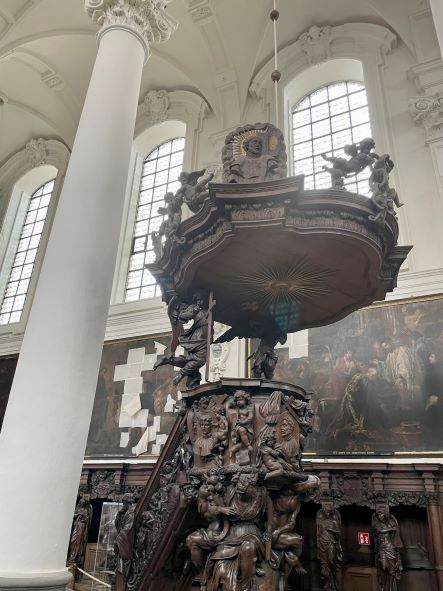When Emily needed to be in Brussels for work, we made it a family trip. Our daughter and I spent time during the workdays exploring Belgium by train. Located between Brussels and Antwerp and only 30 minutes away is Mechelen. Mechelen proved to be well worth a day-trip because of how close the historic sites are to each other and how much smaller and quieter Mechelen is compared to other major cities.
Arrival and walk to the Grote Markt. Mechelen’s train station has been party modernized and, while certain parts are sparse, there are four tracks with brand new platforms. The walk from the station to the city center is easy and flat. The old town is encircled by the River Dyle and quickly, Mechelen’s charm is apparent with a pretty bridge and footpath over the river. We walk to Grote Markt, which is the central square in the historic centre. On one side of the square is the domineering St. Rumbold’s Tower and on the other is the gilded Town Hall. The houses around the Grote Markt are from different times and built in different styles, from sixteenth-century renaissance to eighteenth-century rococo.



St. Rumbold’s Cathedral. This is part of why we came to Mechelen. St Rumbold’s was built in the thirteenth century and is impressively tall. The church survived the religious wars in the sixteenth century and massive bombing damage in the Second World War. The inside of the cathedral is stunning and the high altar, dating from 1665, is an absolute gem. While we are here, we find out that Mechelen boasts a number of impressive churches and UNESCO world heritage sites featured in a scavenger-hunt style pamphlet for touring. Because all of the churches are free, hitting all of these sites quickly became an important goal before we left Mechelen.






Brouwerij Het Aker. This is the other reason for coming to Mechelen. Het Anker started brewing beers 5 generations ago in Mechelen’s Great Beguinage. Now, the brewery has a hotel, a brasserie, and on-site distillery. The major draw is the Gouden Carolus Classic, which is named after the golden coins of Emperor Charles. We stopped in for a lunch of fish and chips and half pints of Gouden Carolus Classic and Golden Carolus Tripel before embarking on the tourist gauntlet to visit all the church sites in Mechelen in an afternoon.



Beguinage Church. Just around the corner from the Het Anker is the seventeenth-century Beguinage Church. The church has a beautiful Italian baroque façade. At each of the churches we visit, the wooden carved pulpits are simply stunning.



Just outside the church is the Large Beguinage. Because of its typical Flemish character and unique architecture, the Large Beguinage was declared a UNESCO world heritage site. Historically, beguinages were founded during the time of the crusades and were small towns within a town. Many of the men who left on a crusade never returned, which resulted in a surplus of women. Women who didn’t enter a convent went to live together and together were able to sustain themselves. The main difference from convents was that the beguines did not take the life-long vows of poverty, obedience and chastity. Initially the church treated them as heretics, but gradually they were accepted.


Church of St. Catherine. In Gothic style, the church was built in the fourteenth century in an area where historically many poor people lived and this is reflected in the church insofar as the vaulted ceiling is made of wood rather than the more expensive stone.



St. John’s Church. By contrast to St. Catherine’s, the parish where St John’s is located was one of the richest parishes in Mechelen because the members of the Great Council lived there. The Great Council was the highest court of law in the Low Countries from the fifteenth century (first under the name Parliament of Mechelen) and it remained in existence until the French Revolution. Built in above the altar is Peter Paul Rubens’ famous baroque triptych. Behind the side panels is a mechanism for turning the paintings at regular intervals so that all the scenes can be admired.



Sint-Pieter-en-Pauluskerk. Baroque in style, the church was originally dedicated by the Jesuits. The interior is richly decorated. According to legend, the church had so many confessionals because it was close to the Veemarkt and there was plenty of lying and cheating when selling cattle. The history pamphlet claims that the real reason was that the church was originally a pilgrimage church and there were many relics, which required the person to be free of sin (having confessed) before touching the relics.



Church of Our Lady of Hanswijk. Built in baroque style, it was one of the first domed churches in the Low Countries. History of the church states that the dome was supposed to be even higher, but the substructure was not strong enough.



Onze-Lieve-Vrouw-van-Leliëndaalkerk (Church of Our Lady of Leliëndaal). A Jesuit church along the main street from the station to Grote Markt. The baroque interior is well preserved. The church furnishings were sold after the French Revolution, which is why most of the interior is sparse.


Church of Our-Lady-Across-the-Dyle. Built in the fourteenth and fifteenth centuries on the site where Mechelen’s first parish church probably stood. The tower contains a complete 49-bell carillon. Inside, we see a Rubens painting commissioned by the fishmongers.






From this last church, we make our way back to the train station and back to Brussels by late afternoon.
